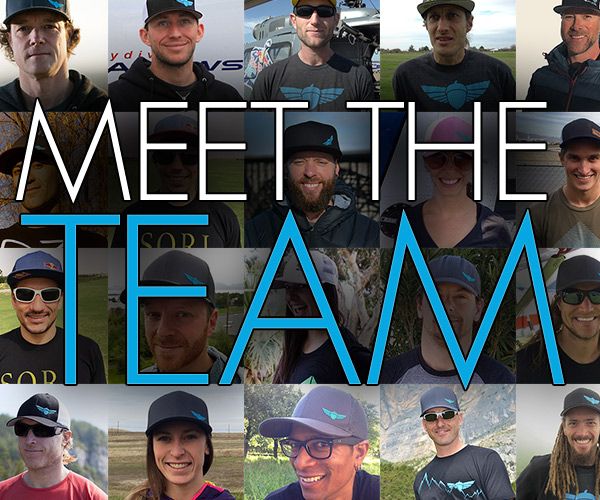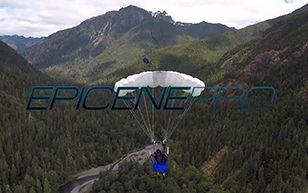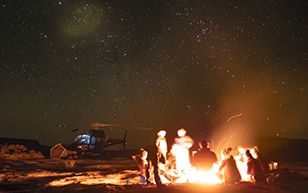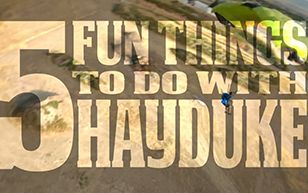Essential Kit
By Keith Forsyth
So, there I was, sawing my paraglider lines with a bike lock key. I was eighty feet up an evergreen tree, with a brake line tied to the tree for back up. Fortunately, I had cell service and called a friend for help, who was quickly in route with a rope. Within a couple hours, my [now] recycled paraglider tag line touched down, the rope came up, I rapped down, and we were out of there.
Let’s back up a bit…
At the time, I was living down the road from an easy hike and fly site and decided to go for a last minute morning lap. I snatched my wing, helmet, and bike, and was off to the landing area. Due to pilot error, I took an asymmetric collapse, and spiraled into the trees below. Although I was unscathed during the incident, I now found myself eighty feet up in the trees with nothing more than a phone and bike lock key in my pocket. I quickly communicated to another pilot in the landing area that I was ‘okay’ and called a friend to bring the proper rescue equipment.
This experience was a huge slap to the face, and a lot of questions crossed my mind.
What if I was in a remote area with no cell reception?
What if I was injured?
Why didn’t I bring my standard kit?
A solid kit is crucial for recreating in the mountains. Piecing together a kit of essential items can be tricky since it varies based on several factors. And, like any tool, a solid kit is only as good as its operator. With flying activities, we are capable of unintentionally placing ourselves in unique locations: in a tree, on the side of a cliff, at the base of a canyon, or the wrong side of a ridge. The kit and operator need to be capable of completing a self-rescue and/or communicating with an outside source to receive the necessary resources.
So, what does my basic kit contain? Let’s begin by creating a few categories.
- Essential items
- Communication
- Repair
- Rescue
- Medical
- Shelter/Clothing
- Food and Water
My kit will vary greatly between different styles of trips, such as the length or remoteness of a trip. For the most part, everything I bring falls into these categories.
1. Essential Items:
These are just by bare minimum, basic items that are with me no matter what.
Headlamp, with extra batteries – One trick I’ve learned is to take out the center battery and flip it around so your headlamp doesn’t accidentally turn on in your pack.
Tape – Duct tape, athletic tape, gaffers tape, it all works, just bring something. From taping hot spots on long hikes, or patching torn jackets, tents, and wings, to covering the light on your Go Pro for those undercover night missions, tape is always useful for something.
Compass – Hopefully this is self-explanatory
2. Communication:
I separate this category into two subcategories when I’m planning a trip: internal and external. How do I intend to communicate with others in my group? How do I intend to communicate to outside parties?
At a minimum:
Garmin InReach – External Communication
Personal Cell phone – Internal/External Communication
(Optional) 2-way radio – Typically for Internal communication
3. Repairs
The items I choose to bring for repairs grows with the length and remoteness of a trip.
Multi-tool – Everybody has their favorite, find what you like and add it to the kit. Try to keep it light(ish) weight.
2mm Dyneema cord – This is one of my Favorites! Super light, strong, and useful. Great for tethering shelters, securing gear, pullup cord, replacing a paraglider line (short term), throw in some knots for a makeshift snow saw, and in an emergency, double (or triple) it up for a bail cord (probably not recommended).
More tape – Throw some on your helmet or around your trekking pole.
Additional items for longer trips: thread and needle, rubber ski straps, zip ties, etc.
Rescue
Personally, I try to pack and be prepared to get myself out of any situation I could get into. Emphasis is on TRY. With the number of places and situations we can encounter, this can be daunting. Nonetheless, you can still be well prepared for a wide variety of outcomes.
Are you a climber? Do you have any rope experience? There are a couple skills you should be aware of and know how to use, such as building basic anchors to bail from, rappelling safely, and a general understanding of the materials being used, and their load capacity. With this knowledge, a handful of carabiners and a short rope could be a starting point for a successful self-rescue.
In my kit:
2-3 alpine draws
Two locking carabiners
25m of 5mm Dyneema with sheath
Research what’s recommended by manufacturers with thinner cord and test it in a controlled environment. Know your gear. Know what you’re comfortable with.
5. Medical
This is another category where it’s more about what you know than what you bring. I took an EMT course to further my education in this area, and the big take away was that I know VERY LITTLE. Seeking education to have a general understanding of Wilderness First Aid should be on your to-do list if you are pursuing adventure sports or big mountain missions.
There is a lot of good reading and recommendations available on the internet. Once again, I try to take into consideration the number of people, length of trip, potential risks, and remoteness.
In my basic kit:
Ibuprofen
Antiseptic Wipes
Cloth
Tape
Chapstick
6. Shelter/Clothing
More is almost always better. I’ve tried to skimp on this category and it usually ends with me hiking out cold, wet, or shivering through the night. If you’re in the Northwest, Gore-Tex is a must. Also, balaclavas go a long way in the winter or summer.
For multi-day trips, I’m continuously trying to make my gear double as part of my bivy setup. This is still in the works, so if you have any good tricks, please let me know.
7. Food and Water
Water – Bring water.
Food – Minimum of one bar or similar size snack for each one to two hours that I plan to be out. I’ve found this works well for me on day missions, and for multi-day missions, I plan based on calories per day.
Knowledge is power in recreating responsibly. Know your limits, know your gear, and know your kit. Think about the things that may be encountered and plan accordingly. Everyone will prioritize differently and the key is to develop a system and kit that fits your needs.
Please feel free to share your favorite pieces of kit, or backcountry tips and tricks.










